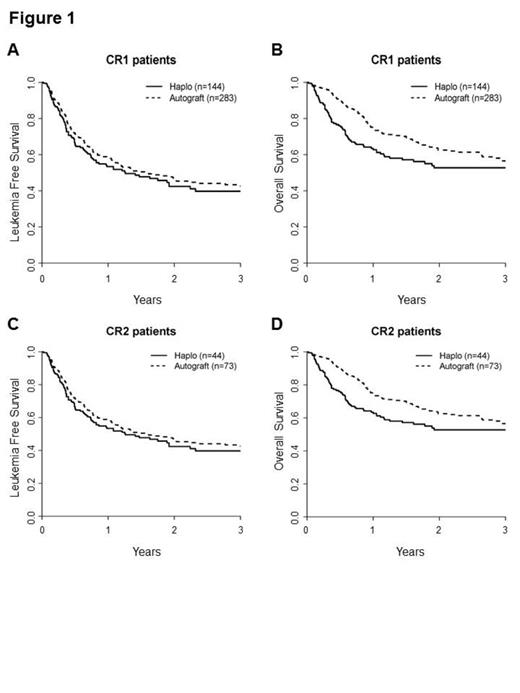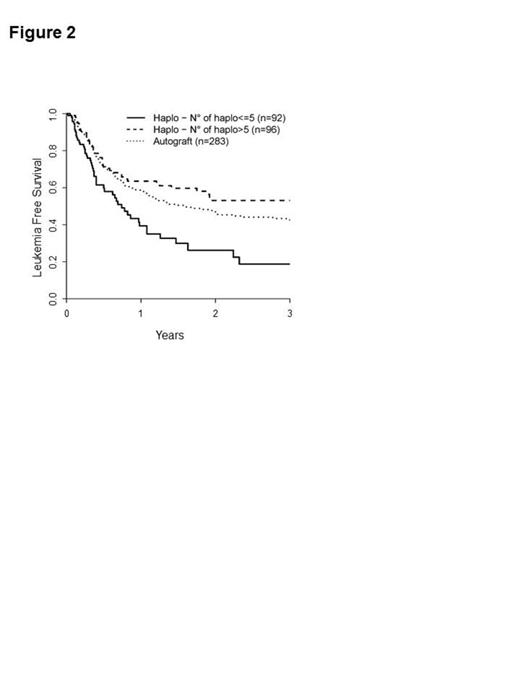Abstract
Adult patients with acute leukemia in need of a transplant but with no genoidentical donor, are nowadays usually considered upfront for an alternative donor transplant, while autologous stem cell transplantation is seldom done. The purpose of this study was to compare the outcome after T cell-replete haploidentical transplant and autologous transplant. We used data from the European Society for Blood and Marrow Transplantation (EBMT) registry. From January 2007 to December 2012, 234 adult patients with acute leukemia, transplanted with marrow from a haploidentical family donor, and 2259 autografted patients were reported to the EBMT registry. We performed a matched pair analysis on 188 haploidentical and 356 autologous transplants using age, diagnosis, disease status, cytogenetics, and interval from diagnosis to transplant as matching factors. The median follow-up was 15 months.
The two-year non-relapse mortality rate was higher post-haploidentical transplant ( 27% versus 4%; p <10-5 ) [hazard ratio (HR): 0.16, p<0.0001], and the relapse incidence was higher after autologous transplantation ( 49% versus 31%, p <10-4) (HR: 1.69, p=0.02). Regarding LFS, there was no difference between haploidentical transplants and ASCT (Figure 1 A and 1 C). Overall survival was higher after autologous transplantation (HR: 0.69, p=0.02) with 63% versus 53% (p=0.01) in all patients, 67% versus 54% (p=0.006) in patients transplanted in first complete remission (Figure 1B), and 45% versus 47% in second complete remission (Figure 1 D). Thirty-six patients with Ph+ ALL received an autograft and 19 received a haploidentical transplant. ASCT was associated with better NRM (8% versus 46%; p=0.002), LFS (53% versus 22%; p= 0.01), and OS (70% versus 19%; p 0.001), while RI was identical (39% versus 32%; p=0.83).
When comparing haploidentical transplants performed in haplo expert centers to ASCT, there was no difference in LFS (haplo: 53% versus ASCT 46%, p=0.17) and OS (haplo: 59% versus ASCT 63%, p=0.58) (Figure 2).
These findings indicate that autologous stem cell transplantation remains a valuable therapeutic option for patients with no identical donors.
Leukemia-free survival and overall survival in patients transplanted in first (A, B) and second remission (C, D). Overall survival in patients transplanted in CR1 (C) is significantly higher following autologous stem cell transplantation (p=0.006 ).
Leukemia-free survival and overall survival in patients transplanted in first (A, B) and second remission (C, D). Overall survival in patients transplanted in CR1 (C) is significantly higher following autologous stem cell transplantation (p=0.006 ).
Leukemia-free survival of patients autografted and patients receiving a haploidentical transplant in haplo expert versus regular transplant centers.
Leukemia-free survival of patients autografted and patients receiving a haploidentical transplant in haplo expert versus regular transplant centers.
No relevant conflicts of interest to declare.
Author notes
Asterisk with author names denotes non-ASH members.



This feature is available to Subscribers Only
Sign In or Create an Account Close Modal